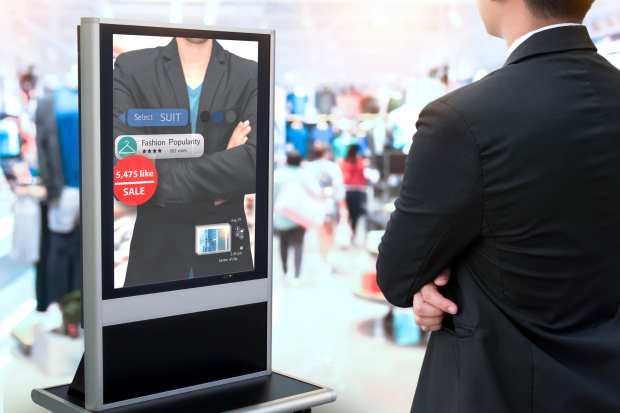Visual Search Hits The Runway At Fashion Week

Visual search and in-store kiosks are expanding their acuity. With a field of competitors that includes Pinterest, Target, ASOS and Google, the category is driving consumer adoption and shopping at a rate that has led key executives to rename the business “visual commerce.”
“Retailers are starting to tap into the camera,” said Ted Mann, CEO of visual search technology provider Slyce. “Consumers like being able to visually try on shoes or makeup with the camera. I think it’s really reached a tipping point now where people are just willing to … experiment with it and the outcome is so positive that people will see it as an expected feature. They expect the retailers to be able to support it.”
Target has incorporated Pinterest’s visual search tool since 2017. StyleSnap is available within the Amazon app, which consumers use by clicking a camera icon in the upper right-hand corner of the app, then uploading a photograph or screenshot. StyleSnap then will present recommendations for similar items on Amazon that match the look in the photo. StyleSnap’s recommendations draw on a number of factors, including brand, price range and customer reviews.
For its part, Mann’s company is moving in several directions. Slyce is working with retail partners to embrace events outside the store and developing new kiosk technology to work within the store.
One of its most high-profile partnerships — and one that will be on display at Fashion Week in New York next week — is with Tommy Hilfiger.
Calling it “see now, buy now” Tommy Hilfiger introduced its visual commerce app via desktop and mobile at tommy.com in September 2019, giving users the opportunity to shop its collection in a “fully merchandised digital environment.” Users can visit a virtual pop-up merchandise shop, browse products on backstage dressing racks and shop styles worn by models. Shoppable tags on each displayed product redirect to shop the item in its own eCommerce environment. For an event in September, cameras placed across the Apollo Theater broadcast live content into desktops or mobile to give users a real-time window into the red carpet, backstage and front row.
“It was shocking to me, I mean, huge numbers of people, not just taking pictures from fashion shows but also browsing the pictures that other people have taken,” said Mann. “And it really has been wildly successful for that. I think brands are trying to figure out a way to use the mobile phone, and use the tools that are unique to the mobile phone to really streamline that extend that path to purchase. It helps brands streamline that path of discovery, and Tommy Hilfiger ended up basically building this entire app around the camera, and around visual commerce.”
Slyce is also placing a bet on in-store visual search kiosks. Currently in use at NAPA Auto Parts as well as other high-profile big box locations, its “Parts Finder” kiosk enables retailers with a high number of SKUs to capture imagery of a part, and add it to an artificial intelligence (AI)-driven metric-learning visual search model to essentially teach the system to recognize new parts. The device is compact enough to enable the product photography to take place in warehouses and stores, so that parts don’t need to be shipped to a remote studio.
Customers and store associates can place any part that has been trained into the device’s lightbox and get an instant, exact-match recognition of the part. NAPA utilizes this kiosk, branded “Drop & Find,” in its stores to aid customers and store associates in identifying fasteners and finding the exact bay and bin in which they are located. With 90 percent exact match on more than 5,000 fasteners sold in store, it is helping solve an age-old problem for customers.
Grand View Research reports that the global interactive kiosk market size was valued at $23.11 billion in 2018 and is expected register a CAGR of 8.9 percent from 2019 to 2025. And National Research Group reports that in terms of visual search, its recent research found that shopping is the number one app category consumers would use more if visual search were integrated, and four out of five visual search users have made purchase decisions or engaged with brands because of social media — 50 percent more than non-users. More than seven in 10 Gen Z consumers currently use shoppable feed experiences to discover more about brands.
“The high level of consumer interest in visual search as a discovery vehicle surfaced very strongly as a part of this research, with eagerness to use this tool as a prompt for both online and offline experiences,” said National Research Group President, Platform and Technology Clients Ben Rogers. “The challenge for marketers will be helping consumers surface what they are looking for effortlessly, immediately, and accurately. Leveraging the power of AI to accomplish this will be critical — the hunger for enhanced experiences around discovery, shopping, and sharing is there.”
The use cases for visual commerce are just starting to show themselves. Using the mobile phone to take retailing anywhere will continue to pique the interest of consumers, especially in the all important digital native category. As Rogers says, AI will start to play a bigger role and “see now; buy now” could become table stakes for retail.
